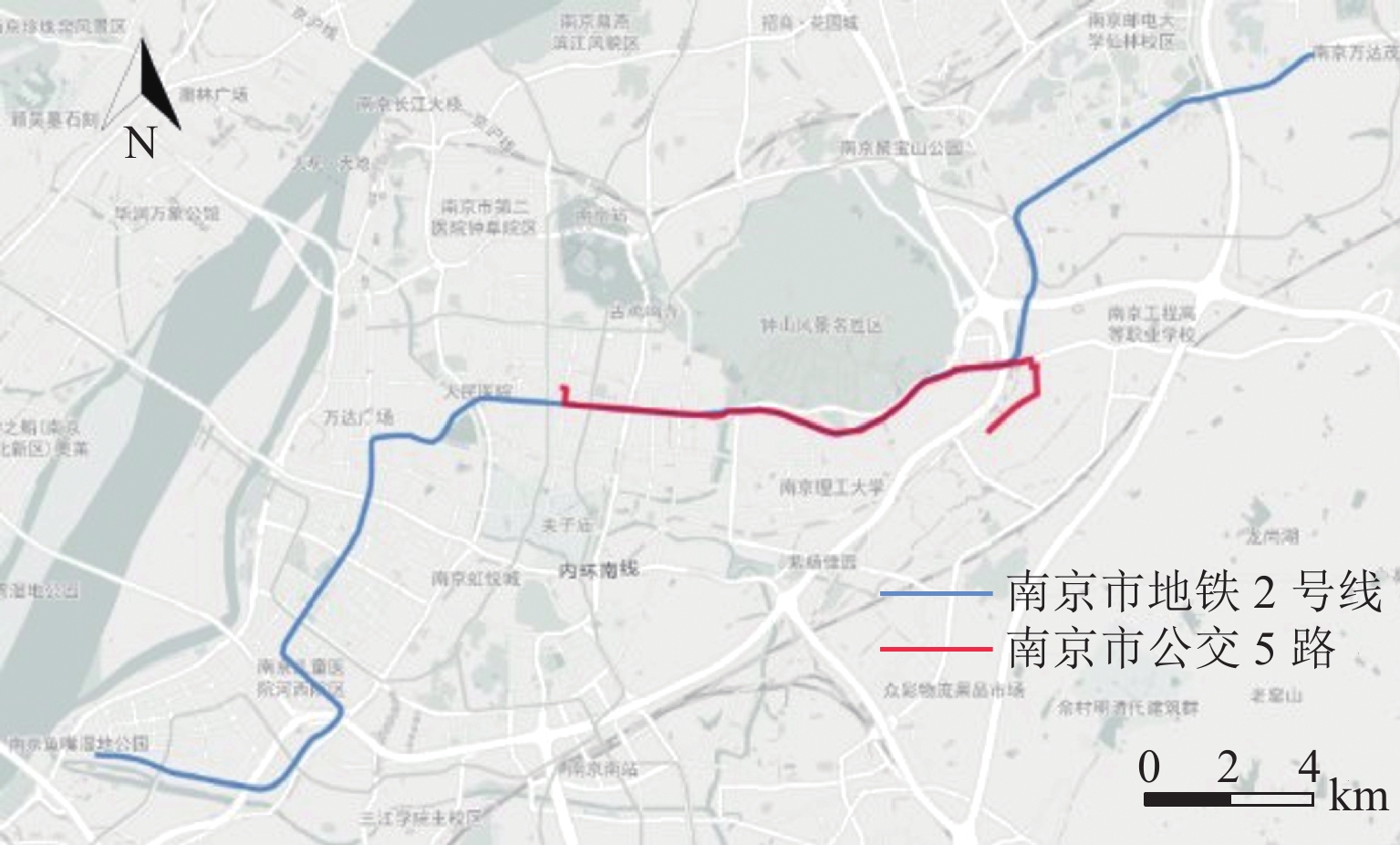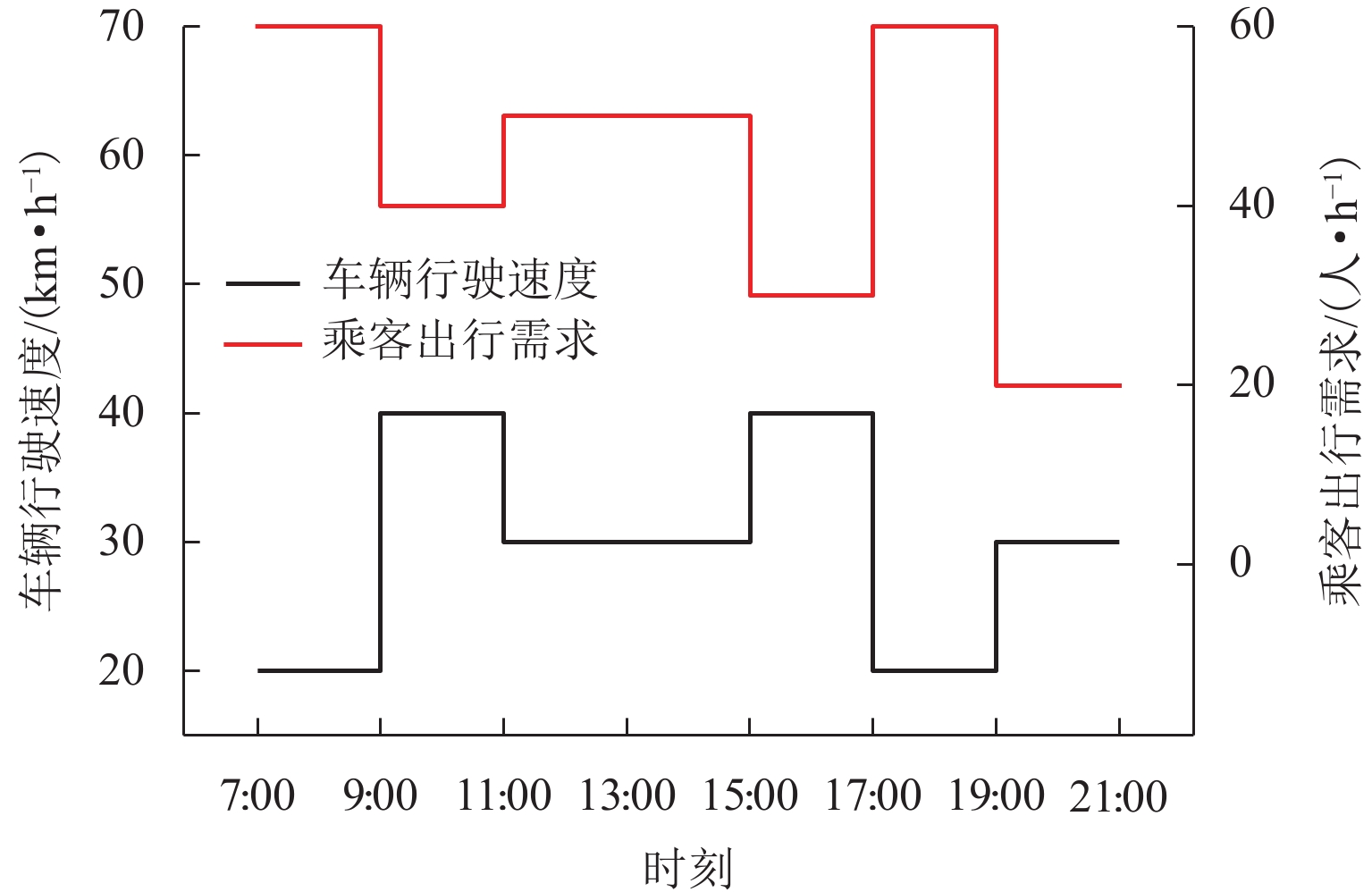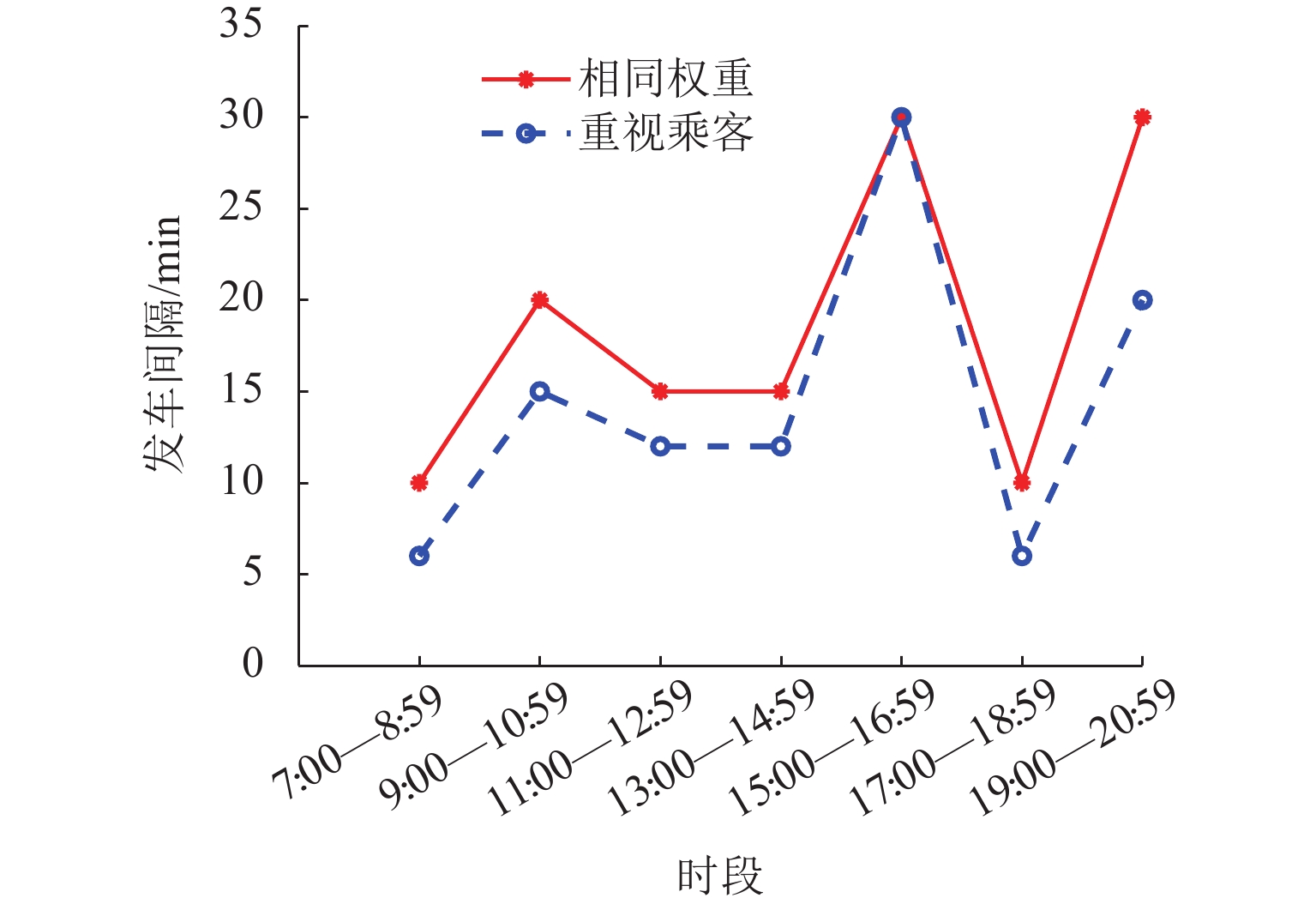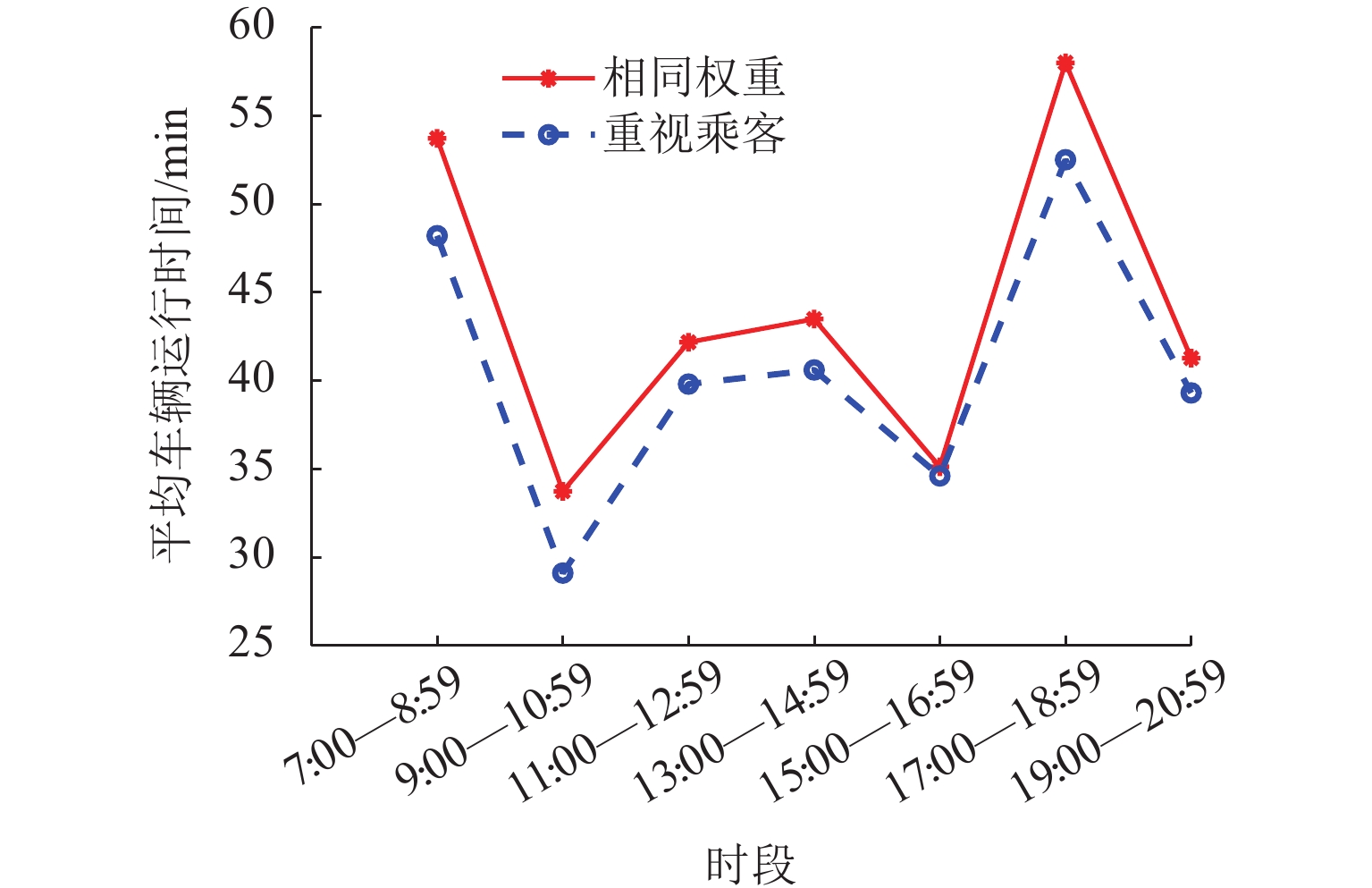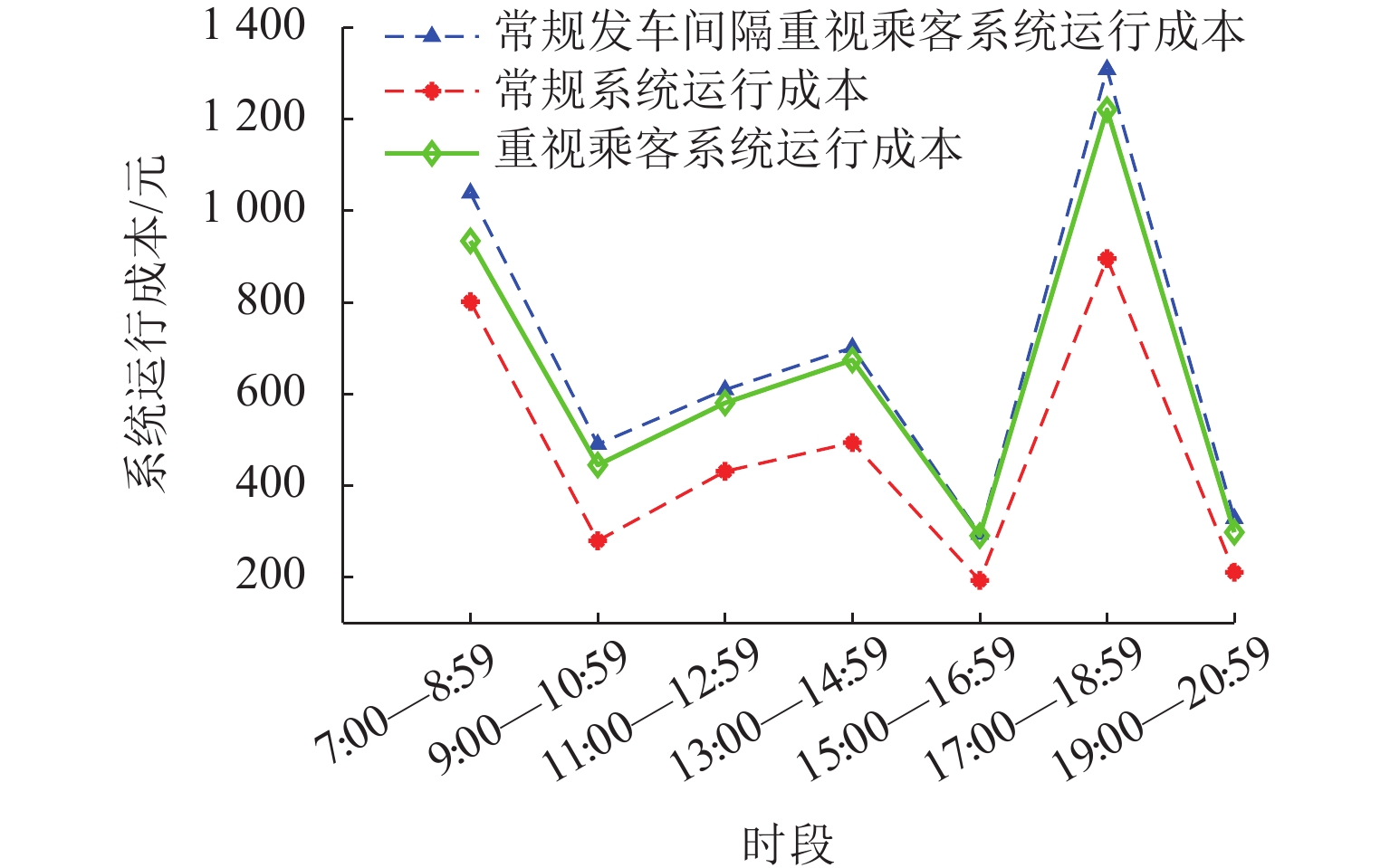Schedule Design Method for Feeder Flex-Route Transit Connecting Urban Rail Transit
-
摘要:
为尽可能满足乘客出行需求,制定科学合理的公交运行时刻表能够保持公交稳定运行的同时降低运行成本. 首先,针对可变线路公交区别于常规定点定线公交的运行特征,提出一种将常规公交转变为可变线路公交接驳地铁的策略,在无需开设新接驳线路的前提下服务原有公交车出行需求乘客和短途出行需求的地铁乘客;然后,通过分析乘客出行行为的规律与特点,根据可变线路公交和地铁的时空信息以及乘客换乘行为的时空参数,利用混合整数非线性规划构建可变线路公交接驳地铁的路径、时间、调度协同优化模型和算法;最后,结合案例,分析车辆运行速度与出行需求水平以及不同时间成本侧重情况对发车间隔、车辆运行时间、运行成本等系统各项指标的影响. 研究表明:在运行周期内适当增加发车频率可以有效降低乘客出行时间成本,且不会增加系统总成本;为可变线路公交接驳地铁的时刻表构建提供了基本理论和自动化编制方法,提高了公交运行效率和服务质量.
Abstract:To cater to passenger travel, a rational transit operation schedule formulated should maintain stable operation and reduce operating costs. Firstly, aimed at the operation characteristics of flex-route transit different from traditional fixed-route transit, a strategy for the transformation of the traditional fixed-route transit into feeder flex-route transit connecting urban rail transit was proposed to serve the original fixed-route passengers and urban rail transit passengers of short-distance travel without opening new feeder routes. By analyzing the rules and characteristics of passenger travel behavior, the mixed integer nonlinear programming was used to construct the model and algorithm for the coordinated optimization of routes, time, and scheduling of the feeder flex-route transit connecting urban rail transit according to the space-time information of flex-route transit and urban rail transit and space-time parameters of passenger transfer behavior. Finally, cases were employed to analyze the influences of vehicle driving speed, travel demand level, and different time cost emphasis on indicators such as departure interval, vehicle operating time, and operating costs. The results indicate that increasing the departure frequency appropriately during operating periods can effectively reduce passenger travel costs without increasing the total system costs. The study provides the basic theory and automatic compilation method for the schedule design of the feeder flex-route transit with urban rail transit, thus reducing travel costs and improving the operation efficiency and service quality of transit.
-
Key words:
- flex-route transit /
- urban rail transit /
- schedule /
- transfer analysis /
- operation coordination
-
表 1 发车间隔设置算法设计
Table 1. Algorithm design of departure interval setting
步骤 指令 输入 发车间隔下限 Hmin,发车间隔上限 Hmax,发车间隔 Hν,其中:Hν = Hmin+v-1≤Hmax,ν = 1, 2, $\cdots $, n 初始化参数 取初始 H1 = Hmin,令最优发车间隔 H* = H1,计算当前U(H1),令最优系统成本 U*(H*) = U(H1) 循环 当 ν < n 时,执行步骤 1、2 步骤 1 在上述基础上,获取新的 Hν + 1,判断是否满足约束,若 Hν + 1 不满足约束,则重复步骤1 步骤 2 计算 Hν + 1 下的 U(Hν + 1),若 U(Hν + 1) < U*(H*),则接受 Hν + 1 作为新的最优发车间隔,H* = Hν + 1,否则保留原来的 H* 步骤 3 若满足终止条件 Hn = Hmax,则输出 H* 和 U*(H*),结束程序,否则返回步骤 1 输出 最优发车间隔 H*、最优系统成本 U*(H*) 表 2 班次设置算法设计
Table 2. Algorithm design of shift setting
步骤 指令 输入 种群规模、交叉概率、变异概率、最大迭代数 Imax 初始化参数 输入运营参数,设置种群数量、交叉、变异概率,最大迭代次数 Imax,初始化种群迭代次数 In = 0 循环 当 In < Imax 时,执行步骤 1~8 步骤 1 编码:染色体采用由 0-1 变量构成的矩阵体现乘客分配和班次设置的二维关系,并假设存在一个新的虚拟班次存放被拒绝的乘客 步骤 2 适应度函数:当完成运营周期内一次完整班次设置之后,计算染色体对应的适应度 步骤 3 染色体更新:1) 在每个乘客和班次完成分配与设置后,将被拒绝乘客的信息反馈给染色体,对相应的基因进行更改,实现染色体的更新;2) 尝试将被拒绝的乘客重新安排回接驳可变线路公交中,提高染色体质量,跳出局部最优 步骤 4 选择:精英保留策略和锦标赛法 步骤 5 交叉:选用单点交叉方式 步骤 6 变异:选用单点变异方式 步骤 7 种群适应度更新并记录最优解 步骤 8 迭代次数更新,In = In + 1 步骤 9 算法终止条件:In ≥ Imax 输出 最优班次 u、最优系统成本 U* 表 3 发车时间设置算法设计
Table 3. Algorithm design of departure time setting
步骤 指令 输入 初始运行站点/线路、出行需求信息、乘客分配情况、车辆班次情况、初始车辆状态 初始化参数 输入出行需求行程时间分布和接驳可变线路公交线路运营各项参数 步骤 1 将乘客起终点在各分配的车辆班次中依次插入 步骤 2 判断约束,若乘客起点或终点的插入会导致可变线路公交违背接驳站的时间约束,则拒绝请求 步骤 3 被拒绝乘客重新安排,明确班次的选择顺序,分别将乘客实际上、下车时间与预计/预约上、下车时间比较,时间成本越小,班次排序越靠前,乘客优先尝试插入到该班次中,不再尝试安排到其他班次 步骤 4 计算得到各班次的运行周期时间、松弛时间和固定站点发车时间 步骤 5 编制接驳地铁的可变线路公交时刻表 输出 最优各班次车辆运行路径、运行周期时间、松弛时间、接驳站发车时间 表 4 固定站点地铁运行时刻表
Table 4. Operation schedule data of fixed stations of urban rail transit
编号 接驳站
(地铁-公交)固定站点
相对位置始发
时间末班
时间r1 新街口(东) 0 06 :11 23 :33 r2 大行宫(东) 1.00 06 :13 23 :35 r3 西安门•浦发银行 2.00 06 :15 23 :37 r4 明故宫(东) 3.40 06 :17 23 :40 r5 下马坊-小卫街 6.20 06 :21 23 :44 r6 孝陵卫 7.20 06 :23 23 :46 r7 钟灵街 8.30 06 :25 23 :48 r8 马群 11.00 06 :00 23 :52 表 5 不同需求水平下不同车速所对应的最优发车间隔
Table 5. Optimal departure interval corresponding to different driving speeds under different demand levels
需求/(人·h−1) 发车间隔 H/min vt=20 km/h vt=30 km/h vt=40 km/h 10 30 30 30 20 30 30 30 30 20 20 30 40 15 20 20 50 12 15 15 60 10 12 15 表 6 不同时段下接驳地铁可变线路公交发车时间间隔
Table 6. Departure time interval of feeder flex-route transit connecting urban rail transit at different periods
时段 vt/(km·h−1) 需求/(人·h−1) H /min 7 :00—8 :59 20 60 10 9 :00—10 :59 40 40 20 11 :00—12 :59 30 50 15 13 :00—14 :59 30 50 15 15 :00—16 :59 40 30 30 17 :00—18 :59 20 60 10 19 :00—20 :59 30 20 30 表 7 系统各运行时段的仿真结果
Table 7. Simulation results of each operating period for system
时段 H/min U/元 平均 ςk/min 发车次
数/次车辆
数/辆7 :00—8 :59 10 801.22 53.71 12 11 9 :00—10 :59 20 279.18 33.73 6 4 11 :00—12 :59 15 430.76 42.17 8 6 13 :00—14 :59 15 493.44 43.48 8 6 15 :00—16 :59 30 192.75 35.12 4 3 17 :00—18 :59 10 895.30 57.99 12 11 19 :00—20 :59 30 210.46 41.27 4 3 -
[1] 夏亮, 江欣国, 范英飞. 基于均值-方差理论的多阶段公交走廊设计[J]. 西南交通大学学报, 2023, 58(6): 1294-1302. doi: 10.3969/j.issn.0258-2724.20210874XIA Liang, JIANG Xinguo, FAN Yingfei. Phased transit service design based on mean-variance theory[J]. Journal of Southwest Jiaotong University, 2023, 58(6): 1294-1302. doi: 10.3969/j.issn.0258-2724.20210874 [2] 蒋阳升, 李衍, 李皓, 等. 基于模块化仿真的共享汽车联合调度优化[J]. 西南交通大学学报, 2023, 58(1): 74-82. doi: 10.3969/j.issn.0258-2724.20210083JIANG Yangsheng, LI Yan, LI Hao, et al. Optimization for joint relocation of carsharing based on modular simulation[J]. Journal of Southwest Jiaotong University, 2023, 58(1): 74-82. doi: 10.3969/j.issn.0258-2724.20210083 [3] 胡路, 梁志梅, 蒋阳升. 拥挤传播对汽车共享系统运行影响的仿真分析[J]. 西南交通大学学报, 2023, 58(3): 499-510. doi: 10.3969/j.issn.0258-2724.20220231HU Lu, LIANG Zhimei, JIANG Yangsheng. Simulation analysis on influence of congestion propagation on operation of carsharing systems[J]. Journal of Southwest Jiaotong University, 2023, 58(3): 499-510. doi: 10.3969/j.issn.0258-2724.20220231 [4] WANG J D, YUAN Z Z, CAO Z C, et al. Optimal bus bridging schedule with transfer passenger demand during disruptions of urban rail transit[J]. Journal of Transportation Engineering, Part A: Systems, 2021, 147(10): 04021071.1-04021071.12. [5] 窦雪萍, 董冉, 李同飞, 等. 考虑乘客排队行为的接驳公交行车计划优化[J]. 系统科学与数学, 2022, 42(12): 3355-3367. doi: 10.12341/jssms22368DOU Xueping, DONG Ran, LI Tongfei, et al. Feeder bus schedule optimization considering passenger queuing behavior[J]. Journal of Systems Science and Mathematical Sciences, 2022, 42(12): 3355-3367. doi: 10.12341/jssms22368 [6] XIONG J, HE Z B, GUAN W, et al. Optimal timetable development for community shuttle network with metro stations[J]. Transportation Research Part C: Emerging Technologies, 2015, 60: 540-565. doi: 10.1016/j.trc.2015.10.007 [7] LIU J R, WU X Y. Research of emergency feeder bus scheme for urban rail transit under unexpected incident[J]. IOP Conference Series: Materials Science and Engineering, 2019, 688(4): 044040.1-044040.7. [8] CHEN Y, AN K. Integrated optimization of bus bridging routes and timetables for rail disruptions[J]. European Journal of Operational Research, 2021, 295(2): 484-498. doi: 10.1016/j.ejor.2021.03.014 [9] 邱丰, 李文权, 沈金星. 可变线路式公交的两阶段车辆调度模型[J]. 东南大学学报(自然科学版), 2014(5): 1078-1084.QIU Feng, LI Wenquan, SHEN Jinxing. Two-stage model for flex-route transit scheduling[J]. Journal of Southeast University (Natural Science Edition), 2014(5): 1078-1084. [10] 赵展轮. 可变线路公交运行时刻表编制方法研究[D]. 南京: 东南大学, 2019. [11] 姚尹杰. 通道型需求响应公交的调度优化研究[D]. 广州: 华南理工大学, 2021. [12] SHANG H Y, HUANG H J, WU W X. Bus timetabling considering passenger satisfaction: an empirical study in Beijing[J]. Computers & Industrial Engineering, 2019, 135: 1155-1166. [13] Federal Transit Administration. TRB’s transit cooperative research program (TCRP) report 100: transit capacity and quality of service manual, second edition[M]. Washington, D. C.: TRB, 2003. [14] 美国交通运输研究委员会. 公共交通通行能力和服务质量手册[M]. 北京: 中国建筑工业出版社, 2010. [15] Avishai C. 公共交通规划与运营──理论、建模及应用[M]. 北京: 清华大学出版社, 2010. [16] ZHENG Y, LI W Q, QIU F. A slack arrival strategy to promote flex-route transit services[J]. Transportation Research Part C: Emerging Technologies, 2018, 92: 442-455. doi: 10.1016/j.trc.2018.05.015 [17] 茧敏, 王卓, 陈哲轩, 等. 基于时空路径推算的城轨网络客流分配方法[J]. 西南交通大学学报, 2023, 58(5): 1117-1125. doi: 10.3969/j.issn.0258-2724.20220545JIAN Min, WANG Zhuo, CHEN Zhexuan, et al. Passenger flow assignment method for urban rail transit networks based on inference of spatiotemporal path[J]. Journal of Southwest Jiaotong University, 2023, 58(5): 1117-1125. doi: 10.3969/j.issn.0258-2724.20220545 [18] QUADRIFOGLIO L, DESSOUKY M M, PALMER K. An insertion heuristic for scheduling mobility allowance shuttle transit (MAST) services[J]. Journal of Scheduling, 2007, 10(1): 25-40. doi: 10.1007/s10951-006-0324-6 [19] ZHENG Y, LI W Q, QIU F, et al. The benefits of introducing meeting points into flex-route transit services[J]. Transportation Research Part C: Emerging Technologies, 2019, 106: 98-112. doi: 10.1016/j.trc.2019.07.012 -




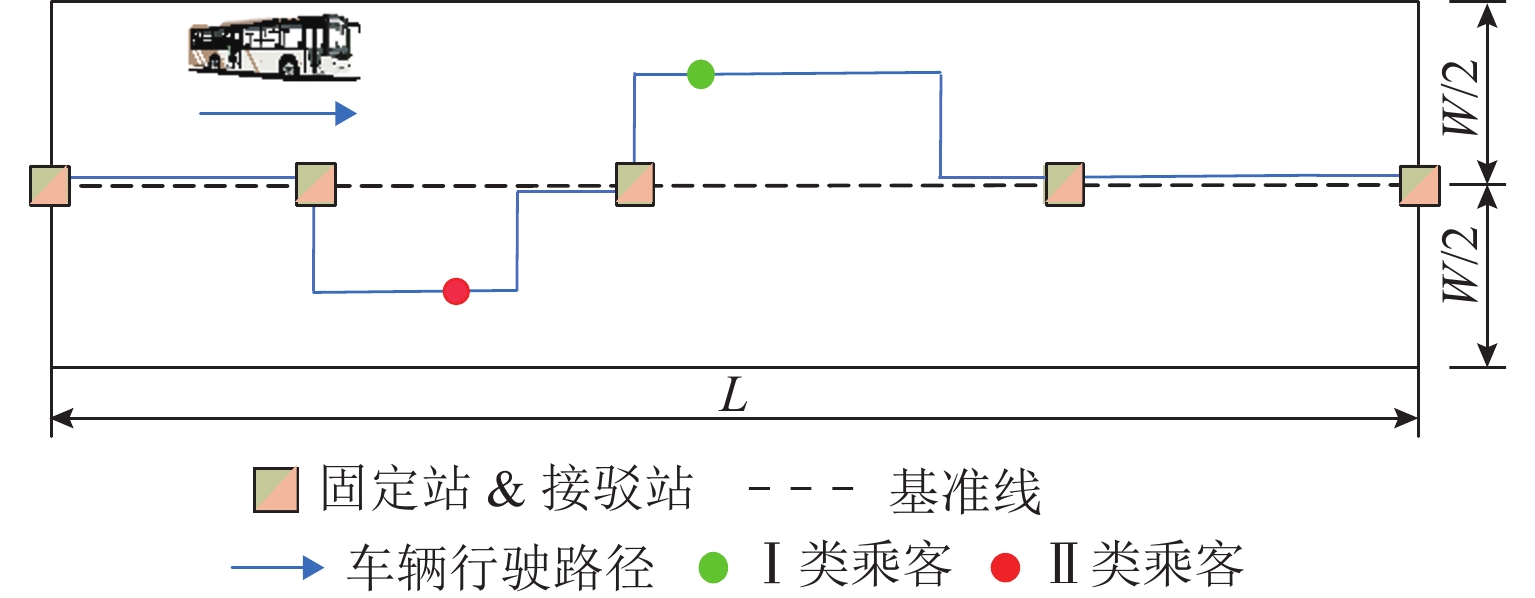
 下载:
下载:

